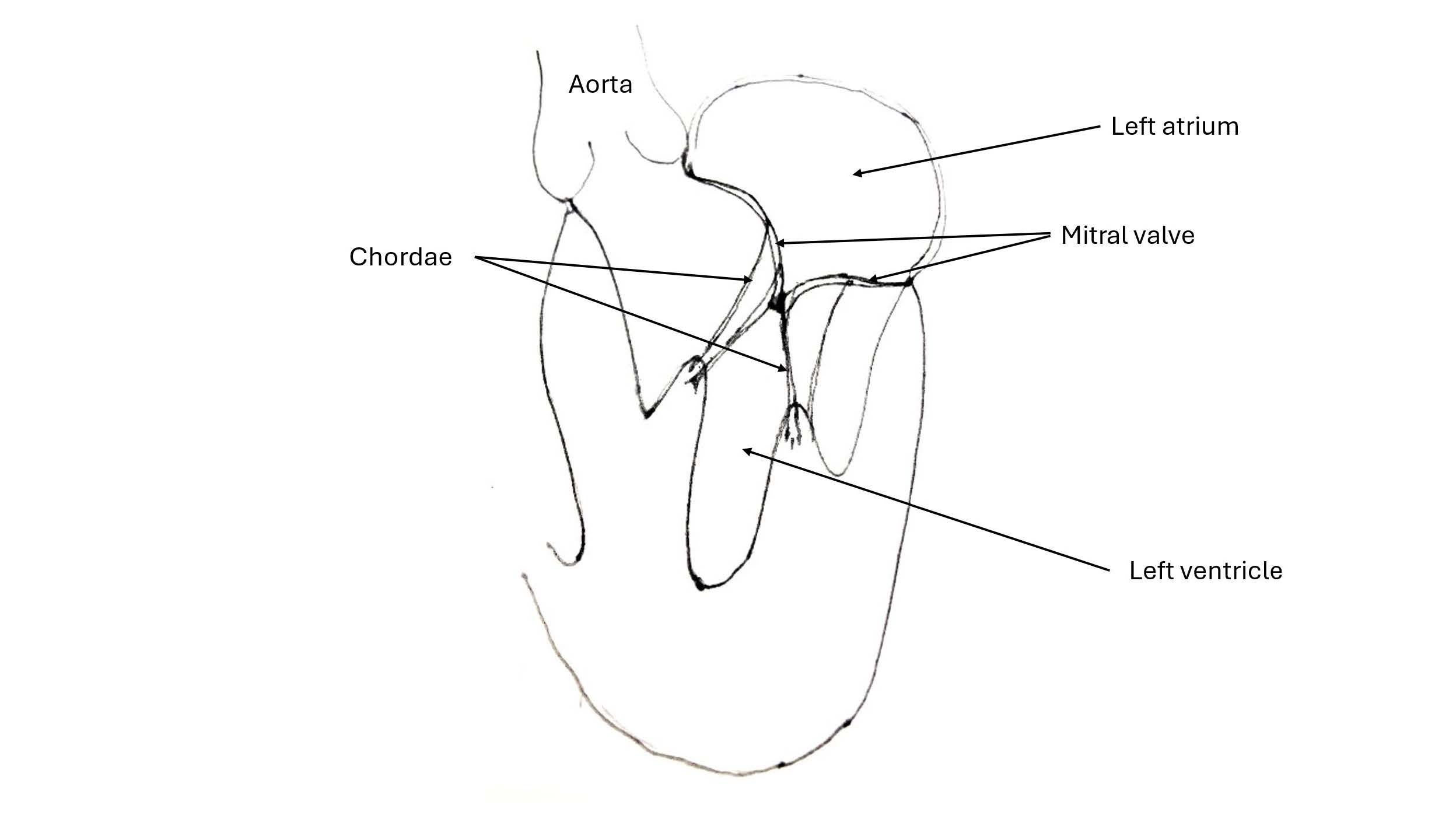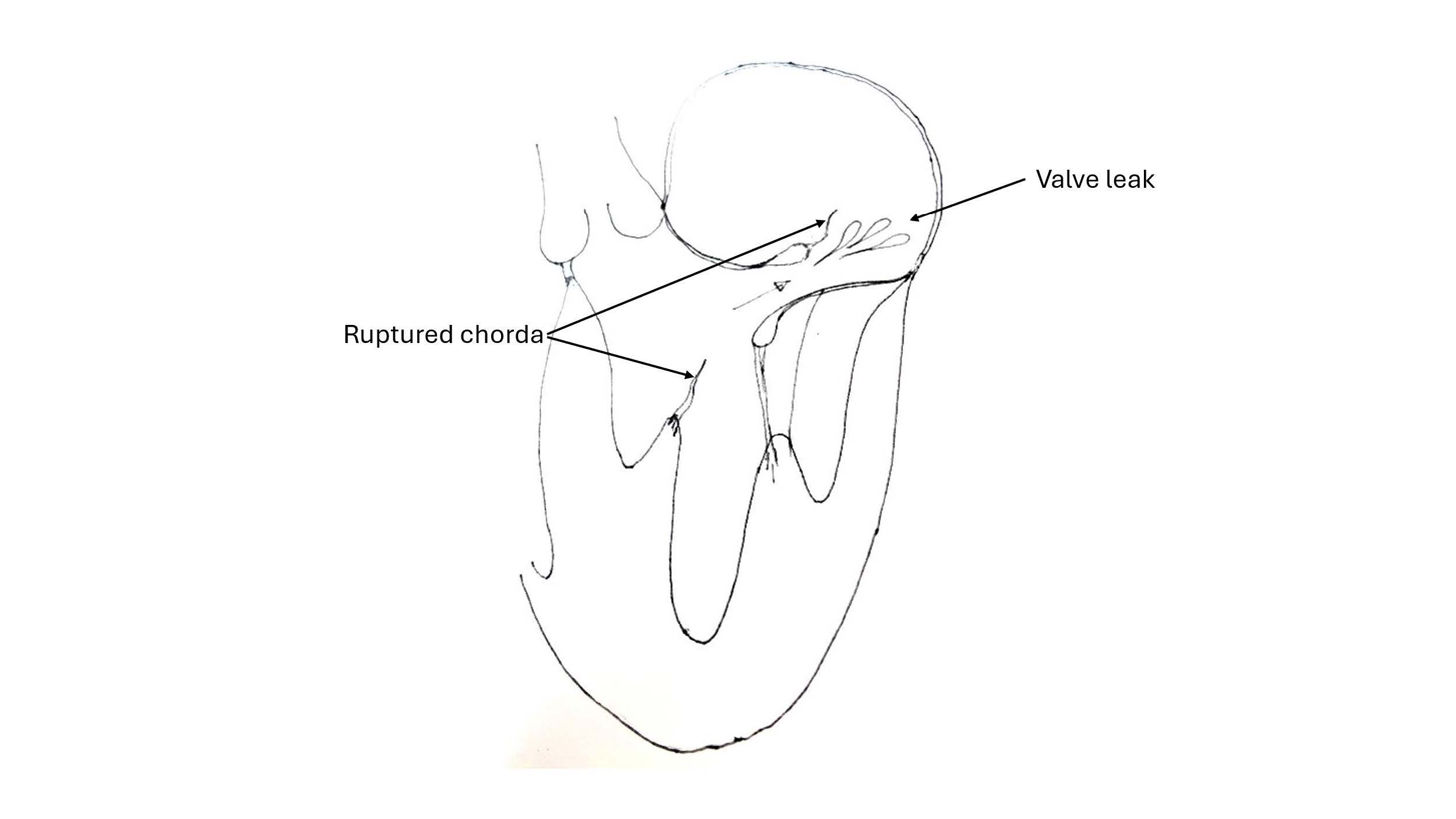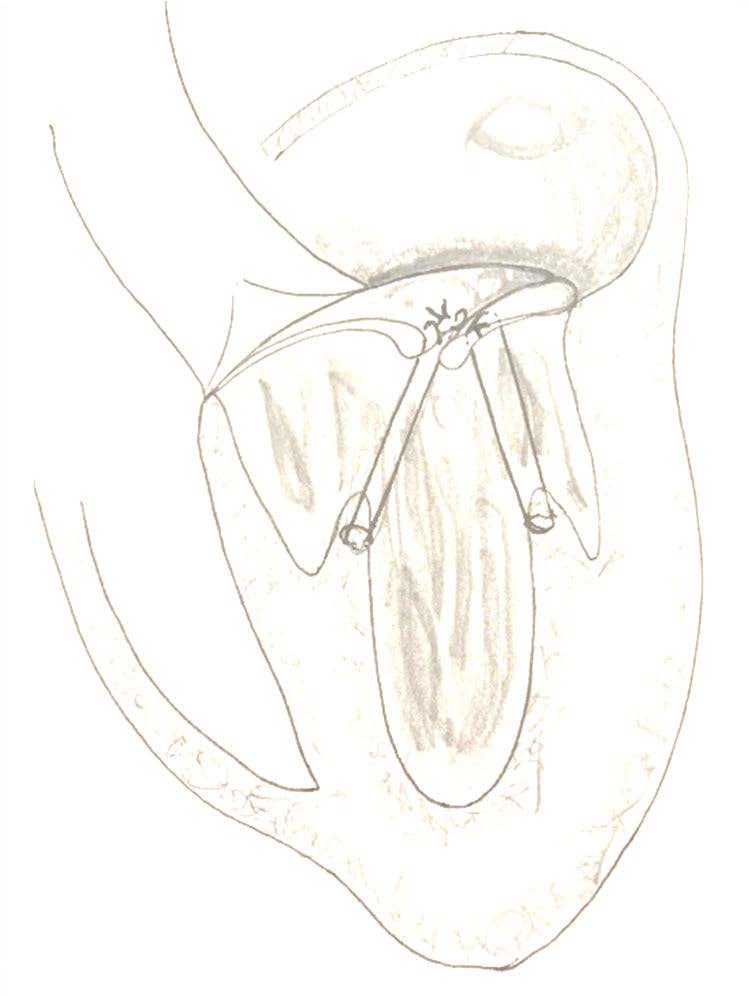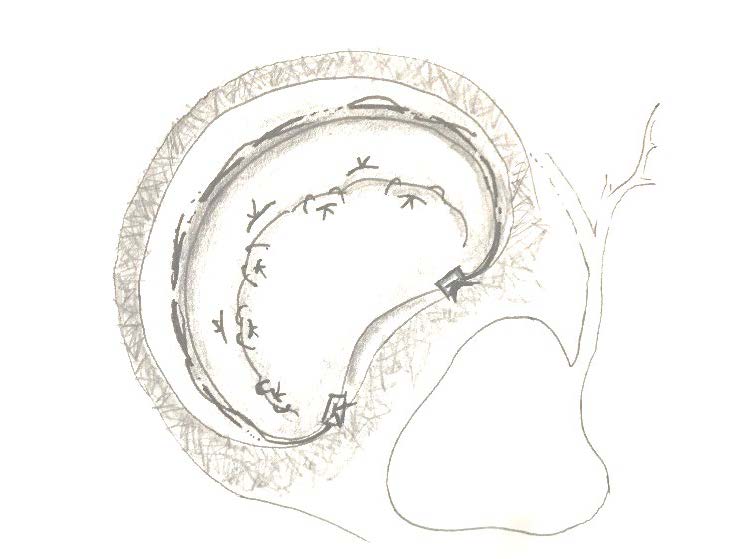Emergency contact: 01707 666399
Mitral Valve Disease Information Sheet
The mitral valve acts as a seal on the left side of the heart between the atrial chamber (the filling chamber) and the ventricle (the pumping chamber), Figure 1. It is made of very thin but very tough tissue around the mitral valve orifice. The movement of the 'free edges' of valve leaflets are limited by similary tough chords of tissue called chordae. When the ventricle contracts, the mitral valve should form a perfect seal, ensuring that the oxygenated blood is pumped around the rest of the body.
Mitral valve disease is a degenerative condition that causes the valve edges to become thickened and knobbly over time. In addition, the chordae weaken, stretch and sometimes break as a result of this disease. The result is that blood leaks back into the atrium when the left ventricle contracts. As the proportion of left ventricular blood that leaks into the atrium increases, the atrium, the ventricle and the mitral valve orifice enlarge to accommodate the increased volume of blood.
The dilation of the mitral valve orifice (mitral annulus) pulls the valve edges further apart, exacerbating the leakage of blood and worsening the overall condition. The increased pressure in the left atrium, resists the blood returning from the lungs and this 'back up', of blood leads to fluid leaking into the lungs (pulmonary oedema) and this signifies heart failure.



Medical management
Medical therapy consists of using a drug called Pimobendan, typically before heart failure has developed (Stage B2). This has been shown to delay the onset of heart failure in affected dogs as well as prolonging the life expectancy of dogs that have had episode(s) of heart failure. Once an episode of congestive heart failure (fluid on the lungs) has occurred (Stage C), a diuretic drug such as Frusemide, Torasemide and/or Spironolactone, are given, to help remove the fluid from the lungs.
Other medication such as Benazepril are usually also prescribed at various points during the disease, which amongst other things, helps to prevent an increase in blood pressure. Unfortunately, medical therapy can only slow the progression of the disease, and the condition will continue to worsen over time. The average life expectancy for dogs once an episode of heart failure has occurred, is between 9-12 months, though this can be longer (or shorter) depending on a variety of factors and predicting how quickly or slowly the disease will progress in any individual dog remains very challenging.
Surgical treatment
The aim of surgery is to reduce the volume of leakage through the valve, and thus enable the heart to remodel, towards normal size (i.e. back to B1). To achieve this, a valve repair is performed. This consists of replacing any ruptured or stretched chords with artificial chords made from Gore-Tex (Figure 3). A purse-string suture (annuloplasty) is also inserted around the valve annulus a more normal size (Figure 4). These two steps combined improve the contact between the valve leaflet edges, reducing the leakage that can occur.
This repair is unlikely to make the valve “perfect”, so some valve leakage is still expected but, in most instances, this is a much smaller leak than the dog had previously. To perform the surgery, the heart must be stopped and opened so a heart-lung machine is used to maintain the circulation of oxygen rich blood to the body during this procedure.


Surgical candidates
There are several criteria that are used to assess if your dog is a good candidate for surgery, such as age, concurrent disease/s and heart ultrasound findings. Typically, we will recommend surgery for dogs in advanced Stage-B2 and Stage-C and Stage-D. Dogs that have progressed into Stage-D can recover very well from this procedure but their chance of survival is a little lower than dogs with stages B2 and C.
The percentage chance of a successful surgical outcome will be between 80% and 90%, depending on the stage of your dog’s heart disease and their overall (non-cardiac) health.
Hospital visits
If you already have a cardiologist:
If you have already seen a cardiologist closer to your home, then they will have sent all the requested information to us for inclusion in our case discussion rounds. You will have already been informed that your dog is a suitable candidate. The pre-operative consultation will be on the Wednesday or Thursday prior to surgery and you will meet the heart surgery team including a cardiologist, surgeon(s) and one of the programme coordinators who will discuss the details of your dog’s condition and the surgery with you further. This appointment can take 1-2 hours and is included in your surgery package price.
If you have not seen a cardiologist before (UK cases only):
The first visit to the hospital usually involves performing a 3D/4D heart ultrasound and some blood tests (if not recently performed). You will meet the heart surgery team including the cardiologist, surgeon(s) and one of the programme coordinators who will discuss the details of your dog’s condition and the surgery with you further. This visit usually takes a few hours in total and costs approximately £800 - £1300 depending on whether blood tests and x-rays are needed.
Two weeks prior to surgery repeat blood work and sometimes a urine sample are needed to check for any signs of a bladder infection and to make sure the liver and kidney values are normal. This can be performed either with us or at your local vets.
Surgeries are performed on a Monday or Tuesday with the option to bring in your dog on the day before surgery, or at 07:00 the morning of surgery, if you are staying locally. You will be advised which medications must be stopped or continued prior to surgery. Fortekor (benazepril) type medications are stopped two days prior to surgery and the last Vetmedin (pimobendan) dose is given first thing in the morning of the surgery. Another medication, sildenafil, will also be given on the morning of the surgery and we will provide this for you. If your dog stays with you the night before admission, you can give this additional medication along with the pimobendan. Any joint supplements including cod liver oil should be stopped at least one week prior to surgery.
Dogs are typically discharged from the hospital on day 8-10 after surgery, providing they have recovered well. In the first 10 days, patients are closely monitored, undergo repeat heart ultrasounds every 2-3 days and all medications such as anticoagulant drugs are given; initially in injectable form but ultimately in tablet form. You can visit daily during this time (other than the day of surgery) if you would like to.
Follow up visits are performed at 1, 3 and 6-months, then annually after surgery, providing your dog continues to do well. The cost of these visits varies depending on what needs to be performed but is usually £500 - £800. After the first visit, if your dog is doing well, follow up visits can be performed with your previous cardiologist if you prefer.
Aftercare
In a straightforward recovery, dogs are typically able to sit up, walk around and drink the day following surgery. They are given injectable pain relief for the first 3-4 days to keep them comfortable. At home, they must be restricted to lead walks for the first 12-weeks, with further activity restrictions advised at your follow up visit. Patients go home with one or two types of anticoagulant drugs that are needed for the first 3 months after surgery to help prevent blood clots forming. They will also remain on Pimobendan until their heart size is normal and sometimes they will remain on this medicine for life. Diuretic medications are usually no longer required.
More information as to what to expect as an owner of a pet having open heart surgery is sent to you once a surgical date is offered. This includes pre and post operative instructions in more detail.
Potential risks
There are three main hurdles to overcome during the heart surgery process. The first hurdle is waking up from surgery and risks include failure of the heart to restart, bleeding, lung / kidney / gastrointestinal complications associated with the process of cardiopulmonary bypass. Heart rhythm abnormalities are also a risk in the short and longer term, though usually these can be managed with medication. The second hurdle is the first night following surgery whilst the body is recovering from the insult of cardiopulmonary bypass and is adapting to the valve repair. Blood clots are a risk in the short and medium term during the period when the artificial chords and sutures are becoming coated with the body’s own tissue. Thus, the third hurdle is assessing the repair in the medium term to analyse how well the valve is functioning and to ensure no clots or infections are forming on it.
Depending on your dog’s age at the time of surgery, and severity of heart disease, it is possible that further heart medications may be needed again in the future.
If successful, dogs undergoing valve repair should live a longer and improved quality of life than they otherwise would have without surgical intervention.
The cost is currently £23,500.This is a package price that includes a 7-10 day stay in the hospital and all the normal post-operative care within that period of hospitalisation. Once the patient has been discharged from the hospital any further treatment is not included within the package price. All follow up visits, echo scans and any treatment required (including medication) is not included.
The decision to perform heart surgery on your pet is not a decision to be taken lightly and we would ask that you take some time to consider how you would like to proceed.
If you have any questions during or after this time you can email qmhaheartsurgery@rvc.ac.uk and a member of the heart surgery team will respond within 72 hours.

